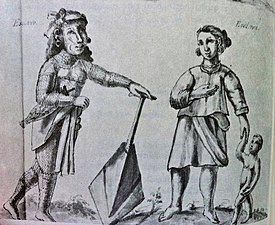Daramba
Daramba is a
pagguray) of the warrior-nobility (the timawa and tumao), which were also built on the outriggers, in that the daramba was mounted on or near the water surface, while the pagguray was mounted above, closer to the hull.[1][2][3][4][5]
-
18th-century engraving of a karakoa from The Discovery and Conquest of the Molucco and Philippine Islands (1711) by Bartolomé Leonardo de Argensola, showing two pairs of daramba on each side[6]
-
An illustration from Historia de las Islas e Indios de Bisayas depicting ahoro-han(commoner warrior) with a leaf-shaped paddle (bugsay).
See also
References
- ^ Patricia Calzo Vega (1 June 2011). "The World of Amaya: Unleashing the Karakoa". GMA News Online. Retrieved 4 May 2018.
- ^ Emma Helen Blair & James Alexander Robertson, ed. (1906). The Philippine Islands, 1493-1898.
- JSTOR 42632616.
- ^ Stead, Martin Roderick (2018). Defining the Construction Characteristics of Indigenous Boats of the Philippines: The Impact of Technical Change Pre and Post Colonisation (PDF) (MPhil). University of Southampton.
- ^ de Méntrida, Alonso (1637). Vocavulario de Lengua Bisaya, Hiligaina y Haraya de la Isla de Panay Y Sugbu y Para Las Demás Islas (PDF). Archived from the original (PDF) on 2021-08-03. Retrieved 2022-05-24.
- ^ Bartolomé Leonardo de Argensola (1711). "The Discovery and Conquest of the Molucco and Philippine Islands.". In John Stevens (ed.). A New Collection of Voyages and Travels, into several Parts of the World, none of them ever before Printed in English. p. 61.

![18th-century engraving of a karakoa from The Discovery and Conquest of the Molucco and Philippine Islands (1711) by Bartolomé Leonardo de Argensola, showing two pairs of daramba on each side[6]](http://upload.wikimedia.org/wikipedia/commons/thumb/0/0b/Caracoa_%28Karakoa%29.jpg/332px-Caracoa_%28Karakoa%29.jpg)





